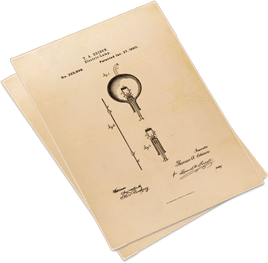One of the essential elements of a patentable invention is novelty. Consequently, disclosure of your invention to others may severely restrict, and can completely eliminate, your ability to claim patent protection in the United States and elsewhere. There are many factors that must be considered in determining whether a disclosure is of a type that will affect your claim of patent protection, especially where patent protection in more that one country is sought. In the matter of disclosure of your invention you are best advised to consult and work with an attorney.
Public Disclosure
General Definition:
- Any publication or public utterance anywhere in the world describing the invention, or any public display of the invention.
- Any public use of the invention or distribution of articles produced by, resulting from, or derived from the invention, or any offer for sale of the invention.
Effect in the United States:
- The inventor must file an application for patent protection within 12 months after the date of publication anywhere, or of public use or offer to sell in this country.
Effect in Most Other Countries:
- The opportunity to claim patent protection is lost.
Confidential Disclosure
General Definition:
- Any disclosure made for the purpose of testing, research, and development of the invention under an understanding or expectation of confidentiality.
- Most disclosures made under a written or express agreement of confidentiality and non-disclosure.
Effect in the United States:
- Provided that the inventor applies for patent protection within a “reasonable” period from the time that the invention has been reduced to practice, the ability to claim patent protection endures.
Effect in Most Other Countries:
- Provided that an inventor files a patent application before anyone else does, the ability to claim patent protection endures.
While the above rules apply generally, there are important differences among countries in the way particular instances of disclosure may be treated as public or confidential. For example:
In the United States (regarding applying for patent protection in the U.S.):
- a disclosure for the purpose of selling the invention, especially for the purpose of gaining a marketing advantage, is considered a public disclosure, even when made under an agreement of confidentiality;
- a confidential oral disclosure is generally not considered a public disclosure, nor is a public oral disclosure, use, or sale that is made outside of the United States; but
- any written or otherwise-recorded report of an oral disclosure, or any documentation of any kind that reveals the invention, to which the public has access (whether or not anyone actually looks at it), is a public disclosure.
In most other countries (regarding applying for patent protection in those countries):
- a private offer to sell the invention is usually not taken to be a public disclosure; but
- an oral disclosure or display of an invention anywhere in the world may be a public disclosure.
Note that Canada, like the United States and unlike other countries, affords a 12-month grace period in which to file a patent application after public disclosure has been made.
In addition, note that patent applications in most countries are “laid open” (i.e., made public) 18 months after they are filed. Publication of a patent application in this way will affect your claim of patent protection, elsewhere, in the same way that any other public disclosure would.
To restate the basic principle regarding disclosure, the issue is not straightforward, and the discussion above has been extremely general. In all cases, and especially if you think you will apply for patent protection internationally, you must consider disclosure carefully, and you will do well to have the counsel of a competent patent attorney in doing so.


